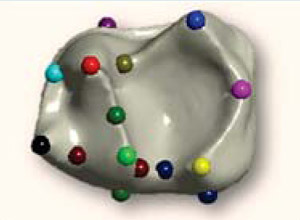Measuring morphological change
DOI: 10.1063/PT.3.1388
Objects alter their form in the course of such physical and biological processes as sedimentation and species differentiation. One approach to understanding those processes is to quantify the degree of morphological change. Suppose, for example, you were presented with a collection of molars, one each from a number of related species. Establishing which teeth were most similar might provide insights into evolutionary dynamics. To facilitate the comparison, you could identify a limited number of cusps or other landmarks on the molar, as in the figure. Once each molar is reduced to some tens of landmarks, straightforward algorithms allow you to determine a scientifically useful, quantitative “distance” measure to express the similarity of any two molar surfaces. But placing the landmarks requires a practiced eye and possibly controversial judgments. To circumvent those difficulties, an international, interdisciplinary team led by Ingrid Daubechies has devised two new methods for defining a morphological distance between a pair of two-dimensional surfaces. Their algorithms consider the entirety of the surfaces—no special markers needed—and, importantly, can be speedily implemented on a computer. As one of several checks on the utility of their methods, the research team calculated the distances between each pair in a sample of 116 molars that had previously been analyzed with a conventional landmark-based technique. With impressive fidelity, both methods devised by Daubechies and colleagues reproduced the earlier results. (D. M. Boyer et al., Proc. Natl. Acad. Sci. USA 108, 18221, 2011.)


